Could Your Dog Have a Yeast Infection?

Table of Contents
Listen To The Article
Introduction to Could Your Dog Have a Yeast Infection?
Dogs can get yeast infections, just like people.
So, if your dog is having a problem with excessive licking, or if you notice big, round, smelly, yeast-like patches in your dog’s fur, she may have a yeast infection.
Yeast infections in dogs are commonly caused by a fungal infection that thrives on moisture and warm, dark environments.
Dogs tend to lick and scratch their skin, which can easily introduce yeast into the fur.
Canine yeast infections, or can be very common in dogs, but very few of us realize that it is happening to our dogs.
Yeast infections in dogs develop when the Candida fungus, which is normally found on the skin, begins to grow and multiply beyond the normal levels.
Dogs can develop a yeast infection in the skin, the mouth, and in-ears.
Just like humans, dogs can experience yeast infections.
These infections appear when an abnormal amount of yeast grows within the body and affects the animal’s skin and ears.
Dogs with yeast infections can develop a wide range of symptoms, such as skin inflammation, hair loss, and itching.
Fortunately, yeast infections are easily treatable with antifungal medications.
In this article, we’ll cover the causes, symptoms, and treatment for yeast infections in dogs.
So many things cause ear infections in pets, that it can be hard to know where to start.
For example, dogs with floppy ears are more prone to infections because their excess skin traps more moisture, providing a haven for yeast.
Likewise, dogs with allergies, which cause itching, are also more likely to develop infections, as are dogs with a history of cancer, which may have compromised immune systems.
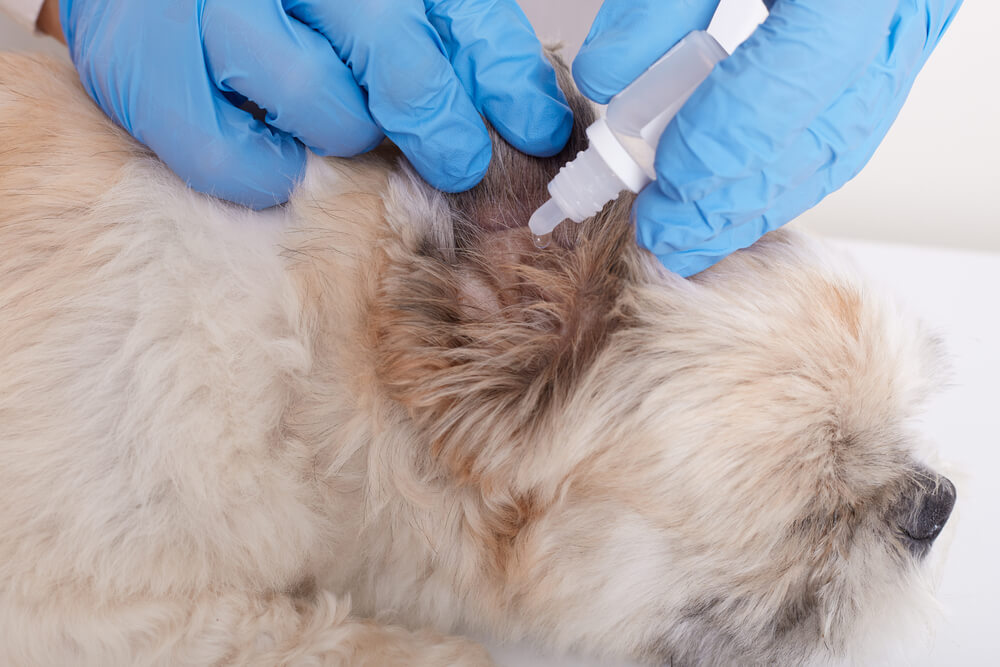
What Causes a Dog Yeast Infection?
Malassezia is a type of yeast that naturally lives on a dog’s skin, in his ears, and in his anal sacs. Normally, it’s kept in check by a healthy immune system.
When the yeast grows out of control, it irritates the skin and causes yeast dermatitis (inflammation of the skin).
Some dog breeds are more prone than others to yeast infections, including:
- Basset hounds
- Chihuahuas
- Dachshunds
- Lhasa apsos
- Poodles
- Shetland sheepdogs
- Shih Tzus
- Spaniels
- Terriers
- West Highland white terriers
But they’re not the only dogs who can get a yeast infection.
In fact, any pup can get a yeast infection, which can be caused by something that lowers the immune system response or disrupts the skin’s natural balance, causing the yeast to multiply and spread.
Common causes of yeast infection in dogs can include:
Allergies
The most common cause of a dog yeast infection is allergies to fleas, food, or substances in the environment.
Allergies can lead to skin irritation and make skin oilier. Some dogs can also develop an allergic reaction to the yeast itself.
Steroid Medications
Vets often prescribe steroid medications to treat dogs with autoimmune disorders and allergies.
These conditions are an overreaction of the immune system.
Steroids weaken the immune system, but also make dogs more susceptible to yeast infections.
Their immune systems are less able to fight off germs.
Antibiotics
Just like yeast, good bacteria are also naturally present on the skin.
They help keep yeast levels in balance.
Antibiotics wipe out all bacteria, both good and bad.
With bacteria out of the way, yeast numbers can grow out of hand.
Underlying Medical Conditions
Some medical conditions like diabetes and seborrhea oleosa (overproduction of oil on skin) create an environment that promotes yeast overgrowth.
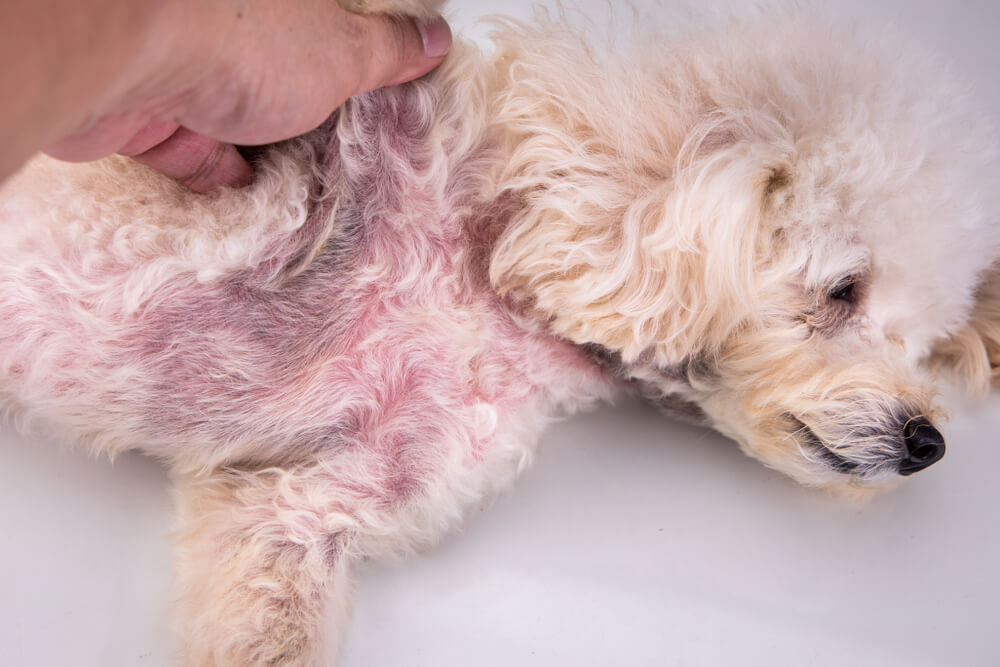
Signs and Symptoms of a Canine Yeast Infection
Just like yeast infections for us humans, yeast infections can make your dog miserable.
Incessant itching and scratching is a telltale sign your pup could be dealing with an overgrowth of yeast.
Here are a few other signs your pup is feeling itchy in the early stages of a yeast infection:
- Biting an area (along with scratching and licking)
- Scooting his butt along the carpet
- Rubbing his body against furniture
- Shaking his head vigorously
- Tilting his head
As the yeast infection progresses, you may also see the following symptoms:
- Red, irritated skin or rash
- Smelly odor
- Discharge from ears
- Sores from scratching
- Brown discoloration of nails
- Darkening or thickening skin (may look like elephant skin)
Skin
Yeast infections can occur anywhere on a dog’s skin, including the belly.
They are often seen in areas that are moist, such as in skin folds, especially in “wrinkly” dog breeds.
The affected skin may be red, irritated, itchy, greasy, or flaky, and there may be hair loss.
If the infection is chronic, the skin may thicken and become darker in color.
Yeast infections on a dog’s mouth or face can cause extreme itching or face rubbing.
Paws
A dog with yeast infections on its paws can have red, irritated, and itchy paws.
The underside of the paws, between the pads, is affected most often, but yeast can occur anywhere on the paws. Sometimes a brown discharge can be seen in the nail beds.
Dogs with yeast infections on the paws usually lick their paws more than normal.
There may also be hair loss.
Ears
Dog ear yeast infections are quite common, and the ears often smell sweet or musty.
Usually, you will see redness, which may extend onto the flap of the ear, and the discharge is generally brown.
The ear may appear to be greasy, and the hair may be matted.
Yeast infections in a dog’s ears can be very itchy, causing dogs to scratch their ears or rub their head excessively.

What’s the Difference Between Ear Mites and Yeast Infections in Dogs?
Yeast infections in a dog’s ears generally cause redness, a brown discharge, head shaking or rubbing, odor, and itching.
Ear mite infections are extremely itchy and can cause many of the same symptoms.
The discharge from the ear is usually dark and waxy or crusty.
Ear mites are barely visible to the naked eye and highly contagious to other animals.
Your veterinarian can easily determine whether a dog’s ear problem is caused by yeast or mites by taking a swab from their ear and looking at it under a microscope.
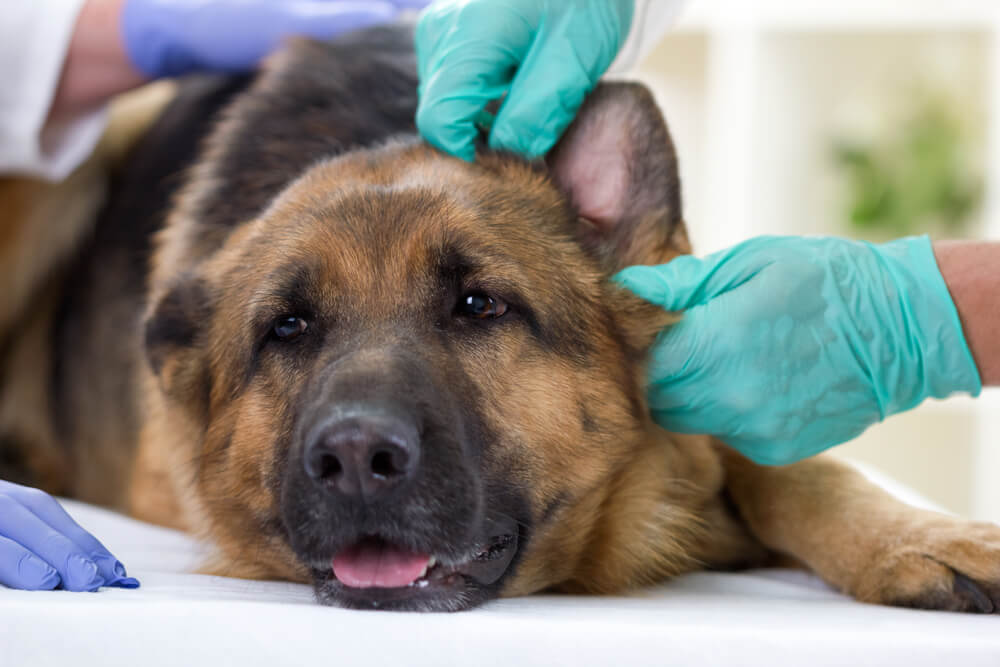
What’s the Best Dog Yeast Infection Treatment?
The best treatment for a yeast infection on a dog depends on the location of the yeast infection.
Ears
Your veterinarian may perform cytology (taking a swab of the discharge and staining it to look at it under the microscope) to diagnose a yeast infection in a dog’s ears.
Prescription treatment may include antifungal drops or ointment, an ear cleaner, and in severe or difficult-to-treat cases, an oral antifungal medication.
Skin and Paws
Cytology is also used to diagnose yeast on the skin.
Treatments for yeast infections on the skin can include topical antifungal creams, wipes, sprays, and shampoos.
Topical ingredients that are effective in treating yeast include chlorhexidine, miconazole, and ketoconazole.
In difficult-to-treat or severe cases, oral antifungal medications are used.
Oral antifungal medications used in dogs include fluconazole, terbinafine, ketoconazole, and itraconazole.
These medications should be used only under the direction of a veterinarian.
Human medications should not be used unless under the direction of a veterinarian.
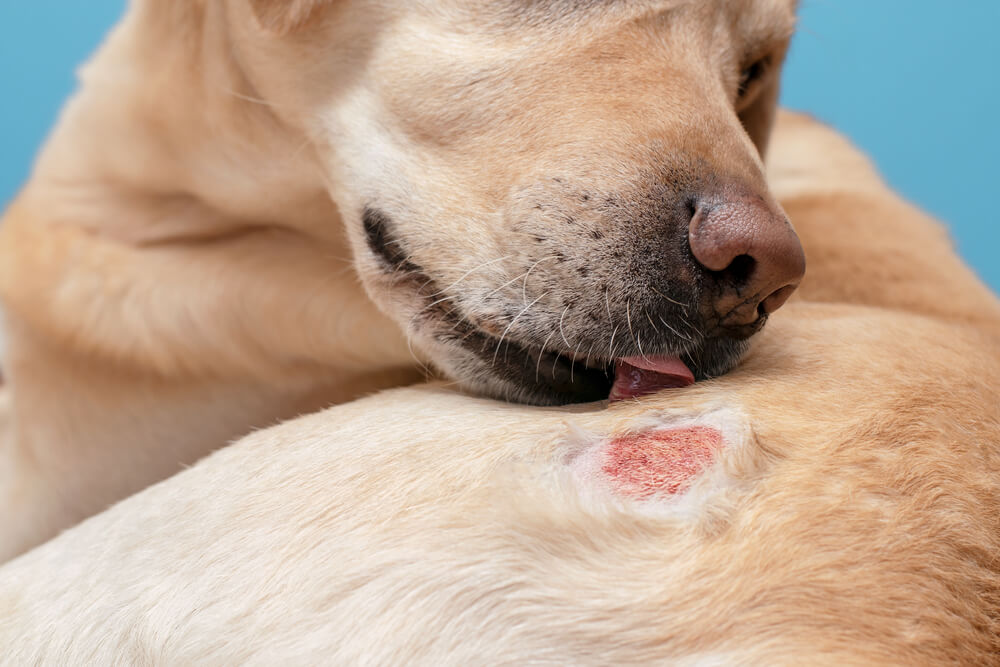
Are There Home Remedies for
Yeast Infections in Dogs?
People often talk about home remedies for dog yeast infections, but most are not proven to be effective.
There are no studies to confirm that feeding any of the following is beneficial in treating yeast on a dog’s skin:
- Yogurt
- Probiotics
- Herbs
- Fermented vegetables
- Coconut oil
- “Yeast-free” dog foods
- “Anti-yeast” dog foods
- Low-carbohydrate dog foods
There are no studies to confirm that topical use of any of the following is useful in treating yeast infections in dogs:
- Coconut oil
- Witch hazel
- Hydrogen peroxide
- Tea tree oil/herbal shampoo
- Essential oils (these may be toxic to dogs)
Vinegar Rinses
Vinegar rinses do have scientific data to support that they may be beneficial in treating yeast. The proper dilution is important to avoid irritation.
Vinegar helps to change the pH of the skin to make it less favorable for yeast. This should only be used under the direction of your veterinarian.
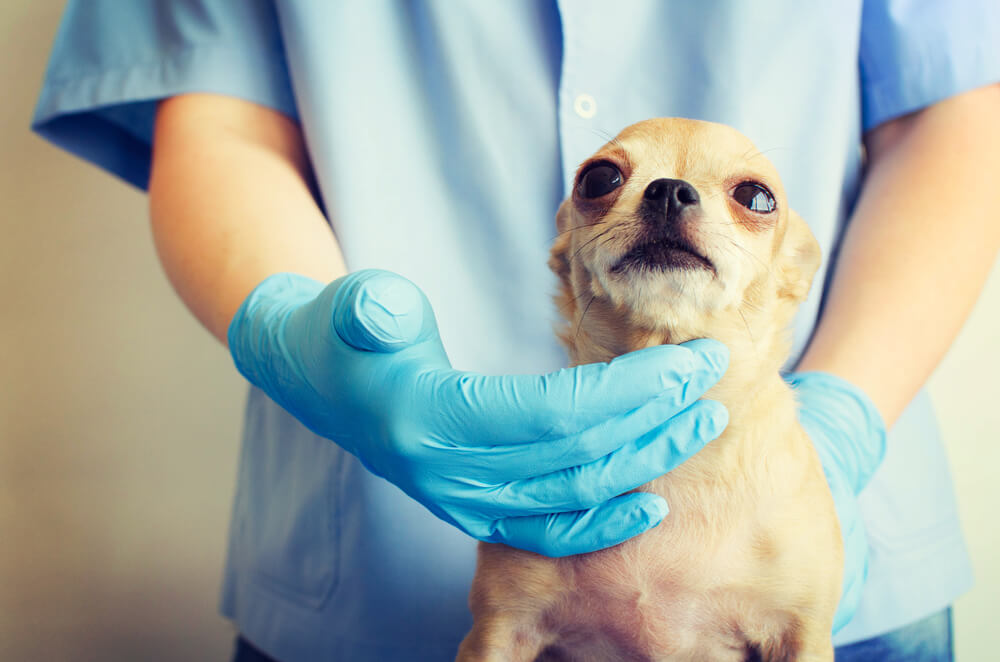
How To Prevent Yeast Infections in Dogs?
Prevention of yeast infections in dogs must include addressing the underlying cause to reduce the likelihood that the infection will reoccur.
Routine bathing with an antifungal shampoo may be beneficial.
However, for shampoo treatment to be effective, the lather must sit on a dog’s skin for a minimum of 10 minutes before rinsing.
Dogs with skin folds may need to have maintenance treatment to keep these areas from becoming too moist, as yeast thrives in moist, dark places such as skin folds and ears.
Dogs that have had allergy testing and are determined to be allergic to yeast can be desensitized by including yeast as an ingredient in immunotherapy (allergy vaccine).
If you suspect that your dog has a yeast infection, consult your regular veterinarian for a diagnosis and treatment plan that is appropriate for your pet.



